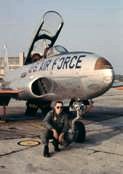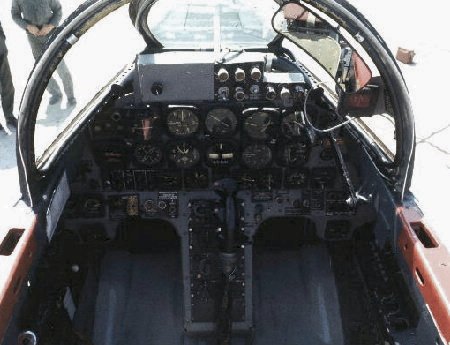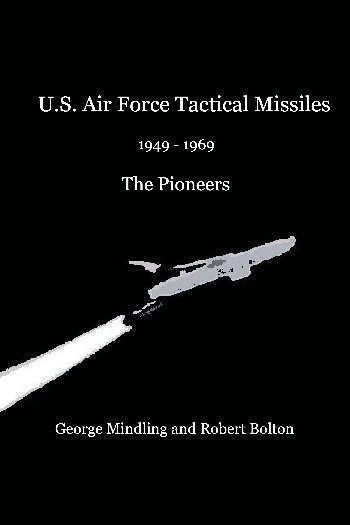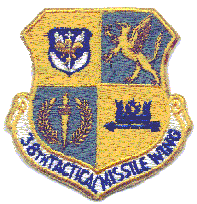|
Sembach Air Base
Hahn Air Base
Bitburg Air Base
Kadena Air Base
Lowry Air Force Base
Orlando Air Force Base
Missile History I
Missile History II
Missile History III
The MM-1
Collectibles
Home Page
|
A Dialog with Launch Officer Lt. Col. Fred Horky, USAF (ret) |
George, Nice hearing from you again. Please allow a dumb question, but I can’t find the “38th TMW web site” to which you refer and where you’d like my writings to reside. There are many, many references to the 38th and Sembach, including more than one veteran’s group. Could you send what links you have and are using? While you’re at it, please copy back to me what I sent before. It might be easier than trying to find it again…. -/-/-/-/- I have hundreds of digitized color slides of Sembach and its environs, including many of the Mace missile, equipment, and support functions. Not knowing if your site includes reports of/about former Missileers, I’ll go ahead and mention that I just heard from Louise Chandler out in Evergreen Colorado, that her husband Scott T Chandler had died in mid-September of complications from diabetes.

"Scotty" had been one of the original launch officers in the cadre that converted the former Security Service radio listening site on the Grϋnstadt hill into the “Site III” which many 38th TMW veterans are familiar. Taken in the winter of 59/60, soon after the original “C” flight arrived from Orlando, this picture shows then 1st Lt Scott Chandler at left with Lt George Burker, another “plank owner” like myself. Shot taken before Site III went operational; we couldn’t park inside the gate afterwards. Note Burker’s 1955 Buick Roadmaster convertible (famous as Der Panzer Amerikaner) at right. |
 Below are a couple of aerial photos of the Grϋnstadt site. The first dates back to BEFORE the missiles, when the Security Service had a intelligence listening post there. I found this 1956 Air Force vertical aerial on a Security Service veterans’ website. While the familiar “T” bldg, “H” bldg, and mess hall are evident, this was long BEFORE the 38th added launch pads in 1959. (They would be at top of picture.) Below are a couple of aerial photos of the Grϋnstadt site. The first dates back to BEFORE the missiles, when the Security Service had a intelligence listening post there. I found this 1956 Air Force vertical aerial on a Security Service veterans’ website. While the familiar “T” bldg, “H” bldg, and mess hall are evident, this was long BEFORE the 38th added launch pads in 1959. (They would be at top of picture.)
|
 My 1961 picture of Grünstadt Site from a T-33; the view is toward the northwest. Obvious again are the “T” bldg, “H” Bldg, and chow hall. I wondered then and still wonder what the “U-shaped” concrete foundation had been, visible in both photos. The original 8 “soft” launch pads are event at right in second picture. My 1961 picture of Grünstadt Site from a T-33; the view is toward the northwest. Obvious again are the “T” bldg, “H” Bldg, and chow hall. I wondered then and still wonder what the “U-shaped” concrete foundation had been, visible in both photos. The original 8 “soft” launch pads are event at right in second picture.
|
 I could go on all night with this nostalgia, but don’t know what the focus of your site is. Here’s an example: in the fall of 1959 our guys building the original “C flight” sign that stood on top of the gate building. Scott Chandler, 2nd from left. This was during the 1959 NATO fall exercise on base at Sembach, Hence the field gear and weapons. Burker and Chandler, at Grϋnstadt. That’s enough for tonight! I could go on all night with this nostalgia, but don’t know what the focus of your site is. Here’s an example: in the fall of 1959 our guys building the original “C flight” sign that stood on top of the gate building. Scott Chandler, 2nd from left. This was during the 1959 NATO fall exercise on base at Sembach, Hence the field gear and weapons. Burker and Chandler, at Grϋnstadt. That’s enough for tonight!
|

|
Fred, I re-read your e-mail and want to explain what I want to accomplish with my web site.First, I want the history of the Tactical Missile Era and it's people to be remembered, not as text book numbers and stats, but as real people and places that are fast fading from our society. I want that history to reflect the personal memories and histories, (which I screen for content, I don't support personal agendas) which I intermix on the site with photos and diagrams. I want the old, original photos and histories as well as the current "what they look like today" photos. To that end, I only use material contributed by people who want their material used, or material that is in the public domain.. All material remains the property of each donor and is acknowledged wherever used in my site. There are no pirated or unauthorized photos on the site, with the exception of the two Air Force Art pieces, which are in the public domain. Second: I want the site to reflect the dedication and level of effort it took to maintain all systems, not just Matador, "A" Bird or "B" Bird, rather all the associated units that interrelated with the 38th, such as the "B" bird Group at Kadena. A history of the systems themselves is an integral part of that story and that is where the MM-1 page comes in. Third, I don't want to compete with the TAC Missileers Association which maintains current rosters and addresses, schedules reunions and publishes regular newsletters. Rather, I want my site to compliment them in a way that helps deliver our message of saving our odd place in Air Force history. They do an excellent job of keeping us all informed of our members who may not be doing as well as others. Hope that helps, look forward to hearing from you. George
|

Yes, it does help. I think I’ll develop what I’ve already written into separate ideas, and not put it all in one. First, to repeat and develop what I had in my first message, about what made up the original, mobile, single-crew, one missile concept. Secondly, some thoughts on training, to include Lowry for tech training, Orlando for crew training with its associated TDY to Holloman for live-fire shots with the Mace. Next, the deployment of “C” flight, 822nd TMS which was slightly different from the rest in that the assigned launch site was an abandoned USAF Security Service radio listening post. Lots of interesting facets to this, including making a “mini-base” with our own security forces, fire, mess hall …even a medic living on-site. There are several ancillary functions that should be included if you have the contacts to do it. For example, the lonely radar sites the provided ground-based radar control of the TM-61 MATADOR. They were an integral part of the 38th’s mission for many years, but little known even at the time by many wing personnel. Do you have anybody who can address that? Another possible theme (and linked to those radar sites) was the “Simulated Missile” mission of a small number of pilots and T-33’s assigned to the wing at Sembach.

The T-birds were modified with the same APW-11 transponder as the missile: after radar acquisition the sim-missile pilot would pretend to be a Matador autopilot. (The only visible evidence was a “light box” seen here on top of the instrument panel glare shield, which gave light signals to the pilot.) | |
My supply friend told me that from their viewpoint, these few T-33’s were the only “operationally coded” T-33’s in the Air Force, as if they were a fighter or bomber.
With their unique radio call sign “Maverick”, these guys provided “simulated missile” targets training and evaluation for a radar ground controllers; while a second site served as scorer. As a pilot, I flew regularly with these guys on my days off from missile duties. That small, close knit group is still having reunions. The flying was very exacting, as it all done very close to a very hostile border across which Soviet air defense pilots would love to have added the “kill marking” of a “sim missile” t-bird onto their airplanes! And hardly anybody at Sembach even knew they were there. Thus, I’d like to make several inputs to you, rather than just one. Is that O.K.? Fred |
 |
Absolutely! We can hardly wait!!
George (Webmaster) |
 U.S. Air Force Tactical MissilesBy the Editors of this Website!
Beyond the Web Page... The only book devoted exclusively to the Matador and Mace Tactical Missiles. The book reveals the story from the initial idea that became the first U.S. pilotless bomber, through the politically troubled development of the ever evolving deployment methods of the Matador and Mace Tactical Missiles. It covers the Units, Groups, Squadrons and Wing that fielded the missiles. From the United States test sites, Europe, Asia and North Africa nothing is omitted. All phases of the application of these two missiles by the U.S. Air Force (and West German Luftwaffe) are included, from the first tentative launches of the XSSM-A-1 Matador in January 1949, to the tense alert duty of the Cuban Missile Crisis, and the final launch of a MQM13A in May of 1977. The maintenance, logistics and launch, the men, equipment and tactics are all there. |

"Bob, George, I finished your book 2 days after I received it. Couldn't put it down. It was incredible reading and incredibly detailed information." Kent Washburn (KWASH55@aol.com) Mace B, Kadena, Okinawa
"George and Bob. I want you both to know how much I enjoyed reading and how much I admire and appreciate what you have accomplished in developing and publishing "The Pioneers". It is truly an outstanding piece of work, reflecting the time and effort required to produce it, but is also a formidable contribution to our military history. I mentioned in some earlier correspondence that I was a little disappointed in the relatively small amount of information regarding the Operating Location/Guidance Sites but you largely made up for it with this magnificent book." Dale Lake (daleflake@yahoo.com) 601st Tactical Control Squadron, 38th TMW, Hamm, Germany
"I just finished your book, The Pioneers, et al. Please accept my "job well done!" Not only is it informative, but it's very readable. I'd also like to complement you on how well you footnoted it. You have shown that a scholarly work can be both instructive and enjoyable." Michael Roof (lavinaschnur@hotmail.com) SGM USA (Ret.)
|  ISBN 978-0-557-00029-6
"Very good work with great detail." Col. Charlie Simpson, USAF, Retired
Executive Director
Association of Air Force Missileers
"George, the book arrived on Tuesday while I was off to France. Of course, I quickly read the chapter about Germany's quiet step into the realm of nuclear armament. You know, this is still a widely ignored fact over here...
...For me it is fascinating to see what the picture really was in the 1950s and 1960s as opposed to what the official communication of the time wanted people to believe. A fascinating book shedding some light on the early days of tactical nuclear missiles as well as the political background that even today is still largely hidden behind the propaganda of the time. Can't wait to read the rest of it." Burkhard Domke
Harsefeld, Germany
"U.S. Tactical Missiles 1949-1969 The Pioneers" |
"I have your excellent book on USAF tactical missiles. I actually witnessed the decommissioning of the Maces at Wüscheim back in 1966." Paul Offen
Talitha, Tye Common Road
Billericay
Essex CM12 9PX
UK
"I just wanted to drop you a line and tell you how much I enjoyed the book that you and Bob wrote. The history was of particluar interest to me and my brother who was a history Professor at the University of Wisconsin. He also thought the book was well written, and he now knows what his little brother, (me), did while in Germany for three years." George Joseph Snyder (gjsnyder@lanset.com)
71st TMS, Steinborn, Germany
"...by the way, I read your book, it was great, thanks for writing it." Hack Hunton (hack@sstelco.com) Mace B, Kadena, Okinawa |
US Air Force Tactical Missiles ©2008 - George Mindling and Robert Bolton | |
Inspired by the 38th TMW Website, George Mindling and Robert Bolton co-authored US Air Force Tactical Missiles 1949 - 1969: The Pioneers ©2008, the story of America's first operational missiles, from the Matador to the Mace, from Taiwan, Korea, and Okinawa to Germany, including Lowry, Orlando, Holloman, Santa Rosa Island at Eglin, and even Camp Happiness! |
|
Dieses Buch ist ein Muss für alle, die im Rahmen ihres Dienstes bei der U.S. Air Force mit den frühen Marschflugkörpern zu tun hatten, aber auch für deutsche Militärarchäologen, die in der Eifel, im Hunsrück oder im Pfälzer Wald schon über rätselhafte Hinterlassenschaften gestolpert sind. Nach mehr als 40 Jahren wird endlich eine Fälle von Fakten, Informationen und Geschichten zu den zwischen 1954 und 1969 in Deutschland stationierten, mit Automwaffen ausgerüsteten amerikanischen Matador und Mace auf den Tisch gelegt. Ausführlich und lebendig erzählen George Mindling und Bob Bolton von den jungen Missilemen, die im März 1954 erstmals in Bitburg ankamen - noch ganz grün im Gesicht, weil auf dem Atlantik schwerer Sturm geherrscht hatte. Von den T-33-Flugzeugen, die aus übungsgründen so taten, als wären sie Matador-Flugkörper, über die Startstellungen hinweg in Richtung deutsch-deutsche Grenze donnerten und sich von der Gegenseite nur nicht erwischen lassen durften. Oder von der Kuba-Krise, als die US Air Force Europe auf DEFCON 3 ging und an die Mechaniker in Bitburg Munition für ihre Karabiner ausgegeben wurde.
Augenzeugen sagen dazu: "Wir hätten die Vögel auf jeden Fall innerhalb von 15 Minuten in der Luft haben müssen!" Es ist lebendige Militärgeschichte, die nun nicht der Vergessenheit anheimfällt, sondern jedermann zugänglich wird - auch für die ortsansässige Bevölkerung, die heute endlich erfährt, was sich damals in ihrer Nachbarschaft zugetragen hat. Den beiden Autoren gebührt der Dank.
Klaus Stark (klaus_stark@t-online.de)
Berlin, Germany
This book is not only a must for all those who served in the U.S. Air Force with the early cruise missiles, but also for German military archeologists who have been puzzling over relics stumbled across in the Eifel, the Hunsrück and the Palatinate Forests. After more than 40 years, we finally have a wealth of facts, information and stories, from 1954 to 1969, of the nuclear equipped American Matador and Mace missiles stationed in Germany placed on the table.
With detailed and vivid descriptions, George Mindling and Bob Bolton talk about the young Missilemen who arrived for the first time in March, 1954, in Bitburg - still green in the face, having prevailed the Atlantic crossing in major storm. Of the T-33 aircraft which practiced as if they Matador missiles launched in the direction of German-German border, or from the Cuban missile crisis, when the U.S. Air Force Europe went on DEFCON 3 and was issued ammunition to the mechanics in Bitburg for their rifles. Eyewitnesses say: "We would have to have the birds in the air in any event within 15 minutes!"
It is vital military history that is prey to oblivion, but is now accessible to everyone - even for the local population, which today finally learns what happened at that time in their neighborhood.
The two authors deserve thanks for saving the history.
Klaus Stark,
klaus_stark@t-online.de
Berlin, Germany
|
 |
This page is in no way sponsored or endorsed by the United States Air Force.
Opinions and views expressed are those of the author and not necessarily those of the Department of the Air Force.
|
All Contributions remain the property of the original owners
All Contributions used with Permission Web Page Design and Development by
George Mindling - Port Charlotte, Florida
©George Mindling - 2003-2006, 2018 All Rights Reserved
|
|



